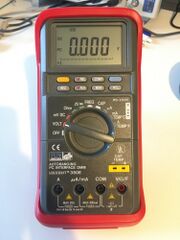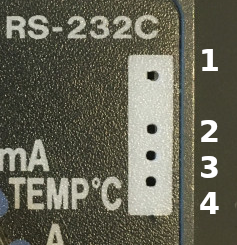Difference between revisions of "Voltcraft VC-350e"
| Line 26: | Line 26: | ||
'''RS232:''' | '''RS232 hardware:''' | ||
* '''Transfer rate''':1200 baud | * '''Transfer rate''':1200 baud | ||
| Line 56: | Line 56: | ||
|} | |} | ||
== | == Serial protocol == | ||
To test on a Linux computer using the screen command, open a terminal like xfce4-terminal, gnome-terminal or xterm and start a session, we will use this terminal to display the data coming from the multimeter: | |||
<code> | |||
/usr/bin/screen -d -m -S serial /dev/ttyUSB0 1200 | |||
screen -r serial | |||
</code> | |||
Then open a new terminal to send commands to the multimeter, example to read the current measurements: | |||
<code> | |||
screen -S serial -X stuff "$(echo -e '\xE0\xFF\r')" | |||
</code> | |||
</ | |||
Output something like "012.003 V". Often the units show garbled, aka you will see "012.003 �" or something especially when using Ohms. I remember I also had this with the original vendor software (which I no longer have). So maybe my device is poor or it was just never developed better. | |||
== Model family == | == Model family == | ||
Revision as of 11:09, 9 September 2020
The Voltcraft VC-350e is a 4000 counts, CAT II (750/1000V) handheld digital multimeter with RS232 connectivity.
It is an OEM version of the Saftec SAF350E. The device was sold by Conrad Elektronik as article 125512 around 1997 and is not available any more.
Hardware
Multimeter:
- Multimeter IC: Maxim MAX134 datasheet
- CPU: SAF350E
- Fuses: 800mA/250V 5x20mm and 20A/250V 6x30mm (superfast, ceramic fuses)
- Battery: 9V NEDA 1604 or 6F22
RS232 hardware:
- Transfer rate:1200 baud
- Characters: 8-bit
- Parity:none
- Stop bits:1
This device uses what looks like a Metex connector, but it only has 4 pins (where 5 pins is seen on other devices).
Cable pinout
| Metex-connector pin (male) | RS-232 DE9-female pin | Signal (multimeter side) | Remarks |
|---|---|---|---|
| 1 | 3 | RxD | |
| - | - | empty space | space between pin 1 and 2 on Metex where there is no pin/hole. |
| 2 | 5 | GND | |
| 3 | 2 | TxD | |
| 4 | 6, 7 | DSR + RTS | DSR and RTS tied together on PC side |
Serial protocol
To test on a Linux computer using the screen command, open a terminal like xfce4-terminal, gnome-terminal or xterm and start a session, we will use this terminal to display the data coming from the multimeter:
/usr/bin/screen -d -m -S serial /dev/ttyUSB0 1200
screen -r serial
Then open a new terminal to send commands to the multimeter, example to read the current measurements:
screen -S serial -X stuff "$(echo -e '\xE0\xFF\r')"
Output something like "012.003 V". Often the units show garbled, aka you will see "012.003 �" or something especially when using Ohms. I remember I also had this with the original vendor software (which I no longer have). So maybe my device is poor or it was just never developed better.
Model family
It seems that this device belongs to a family of several similiar devices and OEM models.
| Metex | Conrad | PeakTech | Radio Shack | RMS | Frequency | Transistor | Logic | Temp | Cap. | Remarks |
|---|---|---|---|---|---|---|---|---|---|---|
| Metex ME-11 | - | ? | RadioShack 22-805 | ? | ? | ? | ? | ? | ? | Amps manual range; seems to be similiar to ME-42
|
| Metex ME-21 | - | ? | ? | - | ● | - | ● | - | - | Manual Range |
| Metex ME-22 | Voltcraft ME-22 | ? | ? | ? | ● | ● | ● | ● | ? | Manual Range |
| Metex ME-22 RMS | Voltcraft ME-22 RMS | ? | ? | ● | ● | ● | ● | ● | ? | Manual Range |
| Metex ME-31 | - | PeakTech 3410 | ? | ? | ? | ● | ? | ● | ? | |
| Metex ME-32 | Voltcraft ME-32 | ? | ? | - | - | ● | - | ● | ● | Amps manual range |
| Metex ME-42 | Voltcraft ME-42 | ? | ? | - | - | - | - | - | - | Amps manual range |
Resources
Measurement functions and ranges
| Measurement function | Range | Resolution | Accuracy | sigrok result | Remarks |
|---|---|---|---|---|---|
| V= | 400.0 mV | 100 μV | ±(0.5% + 3) | mq V, unit V, mqflags DC | " |
| 4.000 V | 1 mV | " | |||
| 40.00 V | 10 mV | " | |||
| 400.0 V | 100 mV | " | |||
| 1000 V | 1 V | " | |||
| V≈ | 400.0 mV | 100 μV | ±(1.0% + 5) | mq V, unit V, mqflags AC | 40 Hz - 100 Hz |
| 4.000 V | 1 mV | " | 40 Hz - 400 Hz | ||
| 40.00 V | 10 mV | " | " | ||
| 400.0 V | 100 mV | " | " | ||
| 750 V | 1 V | " | " | ||
| A= | 4.000 mA | 1 µA | ±(0.8% + 3) | mq Curr., unit A, mqflags DC | |
| 400.0 mA | 100 µA | ±(1.2% + 3) | " | ||
| 20.00 A | 10 mA | ±(2.0% + 5) | " | ||
| A≈ | 4.000 mA | 10 µA | ±(1.0% + 5) | mq Curr., unit A, mqflags AC | |
| 400.0 mA | 100 µA | ±(1.5% + 5) | " | ||
| 20.00 A | 10 mA | ±(3.0% + 5) | " | ||
| Ω | 400.0 Ω | 100 mΩ | mq Res., unit Ω, mqflags - | Continuity beep < 50 Ω | |
| 4.000 kΩ | 1 Ω | " | |||
| 40.00 kΩ | 10 Ω | " | |||
| 400.0 kΩ | 100 Ω | " | |||
| 4.000 MΩ | 1 kΩ | " | |||
| 40.00 MΩ | 10 kΩ | " | |||
| Diode | 2.000 V– | 1 mV | mq V, unit V, mqflags DC,DIODE | Max. 1.5 mA | |
| Data Hold | - |
The column "sigrok result" contains in short form what the driver generates for the resp. data type.
The device seems to be extremely slow when the RS-232 interface is enabled and often takes up to about 10 seconds to detect a changed value or switch to another range. During this time a previous value keeps being sent. When changing to a new range automatically or manually, the device might send the old value scaled to the new range for a short time. This behaviour is caused by the device, not by sigrok! It improves slightly in manual range.

